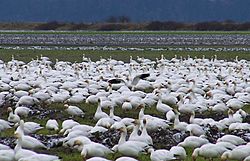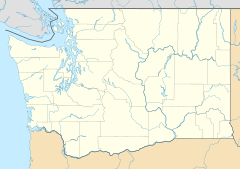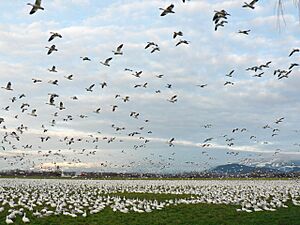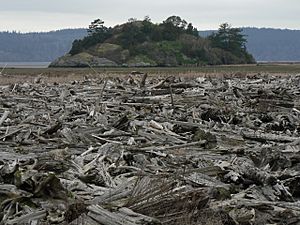Fir Island (Washington) facts for kids
Quick facts for kids
Fir Island
|
|
|---|---|
|
Island
|
|

Snow geese on Fir Island, Skagit River Delta
|
|
| Country | United States |
| State | Washington |
| County | Skagit County |
| Bodies of Water | Skagit River and Skagit Bay of Puget Sound |
| Area | |
| • Total | 15.5 sq mi (40 km2) |
| Time zone | UTC−8 (PST) |
| • Summer (DST) | UTC−7 (PDT) |
Fir Island is a special piece of land in Washington state. It is located in the southwestern part of Skagit County. The island is surrounded by the North and South Forks of the Skagit River and Skagit Bay, which is part of Puget Sound.
The island is shaped like a triangle. It is about 5.3 miles (8.5 km) wide from east to west and 6.5 miles (10.5 km) long from north to south. Fir Island covers an area of nearly 9,900 acres (40 km²). About 195 families live on the island.
Bridges connect Fir Island to nearby towns. One bridge leads to the village of Conway. Another bridge crosses the North Fork of the Skagit River and goes to La Conner, which is about 3.7 miles (6 km) away. Long ago, a town called Skagit City was located near the northeast tip of Fir Island. It became smaller after log jams in the river were cleared in 1877.
Contents
Amazing Wildlife of Fir Island
Fir Island is a very important home for many animals. It is a big part of the Skagit River Delta. This area is especially important for birds that travel long distances.
Snow Geese: Winter Visitors
Every winter, between 30,000 and 70,000 snow geese come to the Skagit River Delta. They fly all the way from Wrangel Island in Russia. These geese also visit the Fraser River Delta in British Columbia. This group of snow geese is very special. They are the only ones that fly between Asia and North America. They are also the only group left in Asia.
Other Migrating Birds
Many other birds also visit Fir Island. These include tundra swans and trumpeter swans. You can also spot bald eagles here. Over a year, more than 180 different kinds of birds have been seen at the Skagit Wildlife Area. This area is about 13,000 acres (53 km²) and has many tidelands and intertidal marsh areas. The largest part of this wildlife area is on the southern side of Fir Island.
Helping Salmon and Other Animals
Near the south end of Fir Island, there is a special project called the Wiley Slough Restoration Project. Its goal is to bring back natural conditions to 180 acres (0.73 km²) of the Skagit Wildlife Area. This project involves removing old dikes (walls that hold back water). It also includes building new dikes and a new gate to control the tides.
The main reason for this project is to help different kinds of animals that live in estuaries. Estuaries are places where fresh river water mixes with salty ocean water. This project is especially important for Chinook salmon. These salmon are listed as a threatened species, meaning they are at risk of disappearing. Even though some hunters did not like the project, many people in the community and Governor Christine Gregoire supported it.
Skagit River Floods: A Natural Challenge
Fir Island sometimes experiences floods from the Skagit River. These floods happen when the river gets too full.
Past Floods on the Island
On November 25, 1990, the Skagit River overflowed its banks. The water flow was 152,000 cubic feet (4,300 m³) per second. The river went over the 10-foot (3 m) tall earthen dikes, and the island was covered in water. No people died, but some farm animals were lost. Fixing the dikes cost $7 million the next summer.
Another big flood happened on October 21, 2003. The river's flow reached 135,000 cubic feet (3,800 m³) per second. The water level was more than 14 feet (4.3 m) above the normal flood stage. About 3,400 people living near the river had to leave their homes for safety.
On November 8, 2006, after a strong storm called a "Pineapple Express," the river flooded again. The flow was 125,000 cubic feet (3,500 m³) per second. The water level was 8.2 feet (2.5 m) above flood stage. These floods often leave large amounts of driftwood along the river and on the tidelands.




